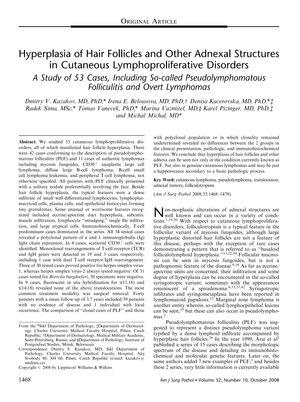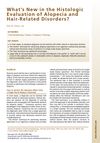Hyperplasia of Hair Follicles and Other Adnexal Structures in Cutaneous Lymphoproliferative Disorders
September 2008
in “
The American journal of surgical pathology
”

TLDR Hair follicle hyperplasia is common in both benign and malignant skin lymphoproliferative disorders, with a proposed new term "pseudolymphomatous adnexitis."
The document summarizes a study of 53 cases of cutaneous lymphoproliferative disorders, including 42 cases of pseudolymphomatous folliculitis (PLF) and 11 cases of genuine lymphomas. It was found that all cases presented with hair follicle hyperplasia, and some also showed hyperplasia of eccrine/apocrine ducts or secretary glandular parts. Immunohistochemical analysis indicated a T-cell predominance, and molecular genetic studies revealed monoclonal rearrangements in 19 cases. No evidence of certain infectious agents was found in the majority of cases, and the most common treatment was surgical removal. The study concluded that hyperplasia of hair follicles and other adnexal structures can occur in both PLF and genuine cutaneous lymphomas, suggesting a spectrum of lesions from benign to malignant, with clonal pseudolymphomas in between. The term "pseudolymphomatous adnexitis" was proposed as more appropriate than "pseudolymphomatous folliculitis." Despite the presence of clonality in some cases, it did not appear to affect the clinical course within the follow-up period. Further research is needed to understand the progression of these lesions.




